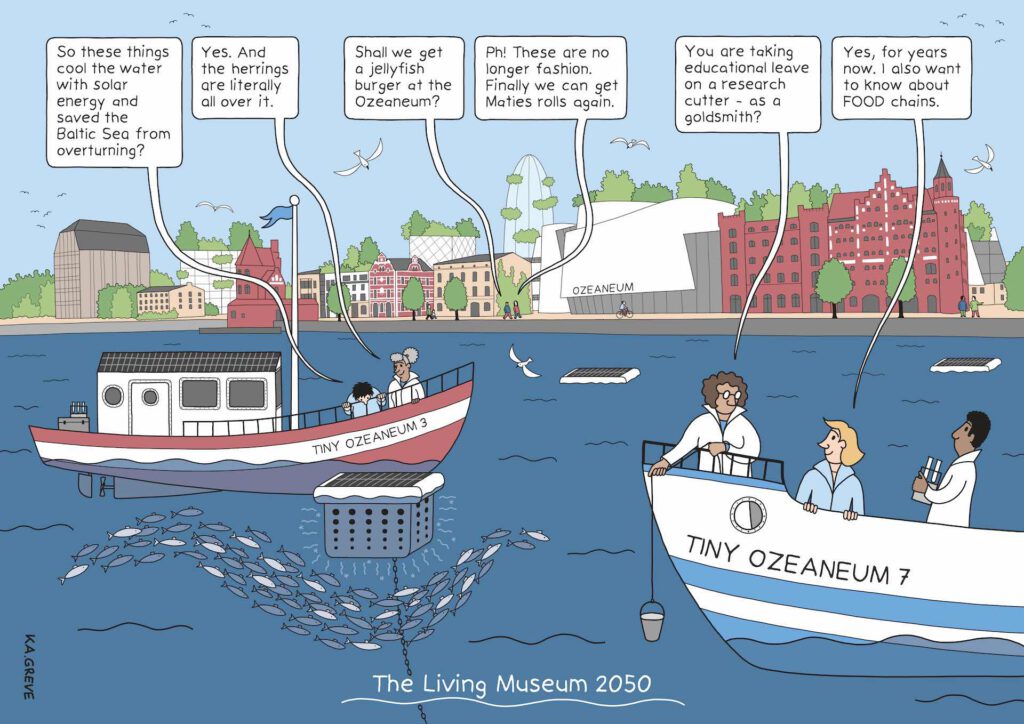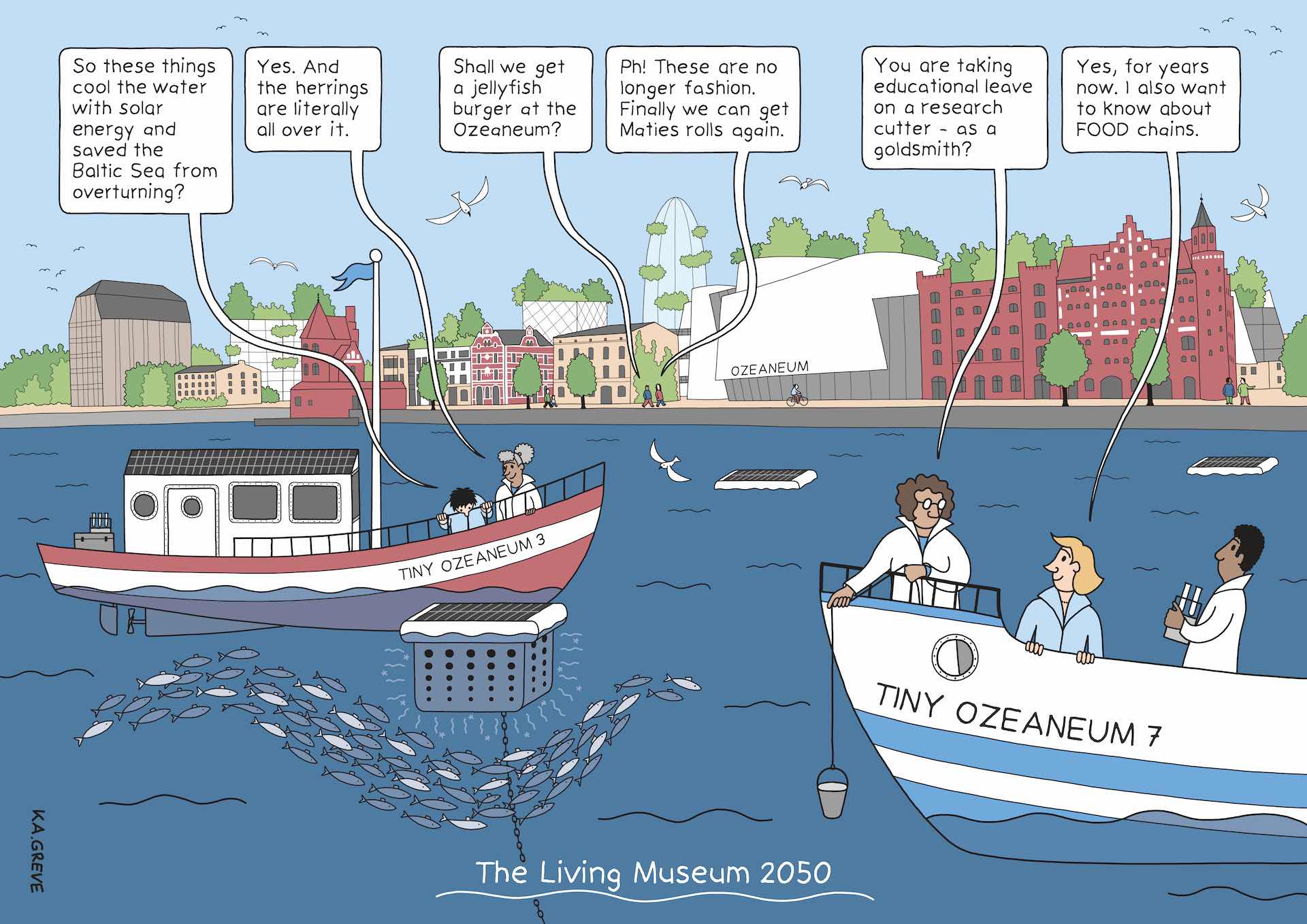The Living Museum by Katharina Grewe
ARTIST // Katharina Grewe
CREATION DATE // 2022
About
ARTIST STATEMENT:
What I really enjoyed about the work was that I was able to visualize ideas for the further development of the Ozeaneum in Stralsund and a positive vision for the Baltic Sea. Being a big fan myself – not only of the Baltic Sea, but also of the museum – I very much hope that such natural and cultural environments will remain with us for a long time.
THE NARRATIVE:
The Living Museum 2050 is localized in Stralsund and revolves around today’s Ozeaneum, the maritime museum. In the imagined scene there, twins meet on a late afternoon. They are twelve years old and want to have something to eat after an interactive exhibition visit at the Ozeaneum. In 2050, it is a normality to order jellyfish burgers instead of herring and matie rolls, since there are hardly any fish left in the Baltic Sea. In the early evening, the two teens are invited on a flashlight tour. They meet up with the other participants in front of the aquarium. This museum tour is about finding out how the herring are doing. The museum is researching how to reintroduce herring to the Baltic Sea. With the flashlight, visitors can see where the herring are moving to. They also investigate the question of where the herring can be reintroduced into the Baltic Sea and where they will be most likely to spawn.
The Ozeaneum of the Future cooperates with the former fishermen. Their cutters have been moored in the harbors for a long time and were no longer used. Now, however, in 2050, the fishermen are on the move with their cutters as researchers. Their cutters serve as a research station andat the same time as an improvisation theater stage. On the one hand, tours take place with interested people who want to learn more about the history of the old fishermen. On the other hand, research trips are organized with scientists who are still trying to restore biodiversity in the Baltic Sea and, of course, to reintroduce the herring. In order to arouse even greater interest in this important research topic, there are large light installations at the reservoir that draw attention to this problem and also allow real-time transmissions from the research cutters to be experienced.
Each research group is interdisciplinary. There are engineers, marine scientists, but also artists – including a goldsmith who wants to understand about food chains. One important project was to use solar-powered temperature regulators in the Baltic Sea to cool the waters down. It took a few years, but now the release of herring will be successful. This is mainly due to a new form of cooperation in which different disciplines as well as transdisciplinary, i.e., with civil society, worked together to find solutions. Every resident of Stralsund and the surrounding areas can do project work on the ship and become part of the research group. It is easy to apply for educational leave for this purpose.
On the day when the twins are now in the museum and want to go on a flashlight tour, they become witnesses to a conversation between politicians and curators who have come together in the museum. They want to organize a big herring party at the Ozeaneum. As they have succeeded in raising enough fish stocks in the museum and the research groups on the cutters have contributed to the fact that the solar-powered, sea-cooling aggregates are working and thus the herring can swarm in the Baltic Sea again. At last, herring rolls can be served again.
ABOUT THE PROJECT:
So far in 2022, the Ocean Future Lab project has held 5 online workshops as well as 4 face-to-face workshops at the German Maritime Museum in Bremerhaven, the Ozeaneum – the German Maritime Museum in Stralsund, the Futurium Berlin and the Berlin International University Berlin.
In the workshops, utopian narratives on the question “How do we want to live with the oceans?” were developed in a transdisciplinary and co-creative way. Some of these narratives have been visualized by participating artists. Now we want to present these results to you. They will be presented in exhibitions of the participating museums, on the internet and social media to broaden the dialogue with a larger audience.
ABOUT THE ARTIST:
Katharina Greve, born in Hamburg in 1972, studied architecture and works as a cartoonist, comic artist, artist and author in Berlin. In addition to contributions in German print media such as Titanic, neues deutschland, DAS MAGAZIN and Süddeutsche Zeitung, she has published a cartoon volume and six comic books, most recently “Die letzten 23 Tage der Plüm.” She has received numerous awards, including the Max und Moritz Prize in the category “Best German-language Comic Strip” at the International Comic Salon Erlangen in 2016 for her webcomic “Das Hochhaus – 102 Etagen Leben”.
Works

More about the Art For Futures Lab here


